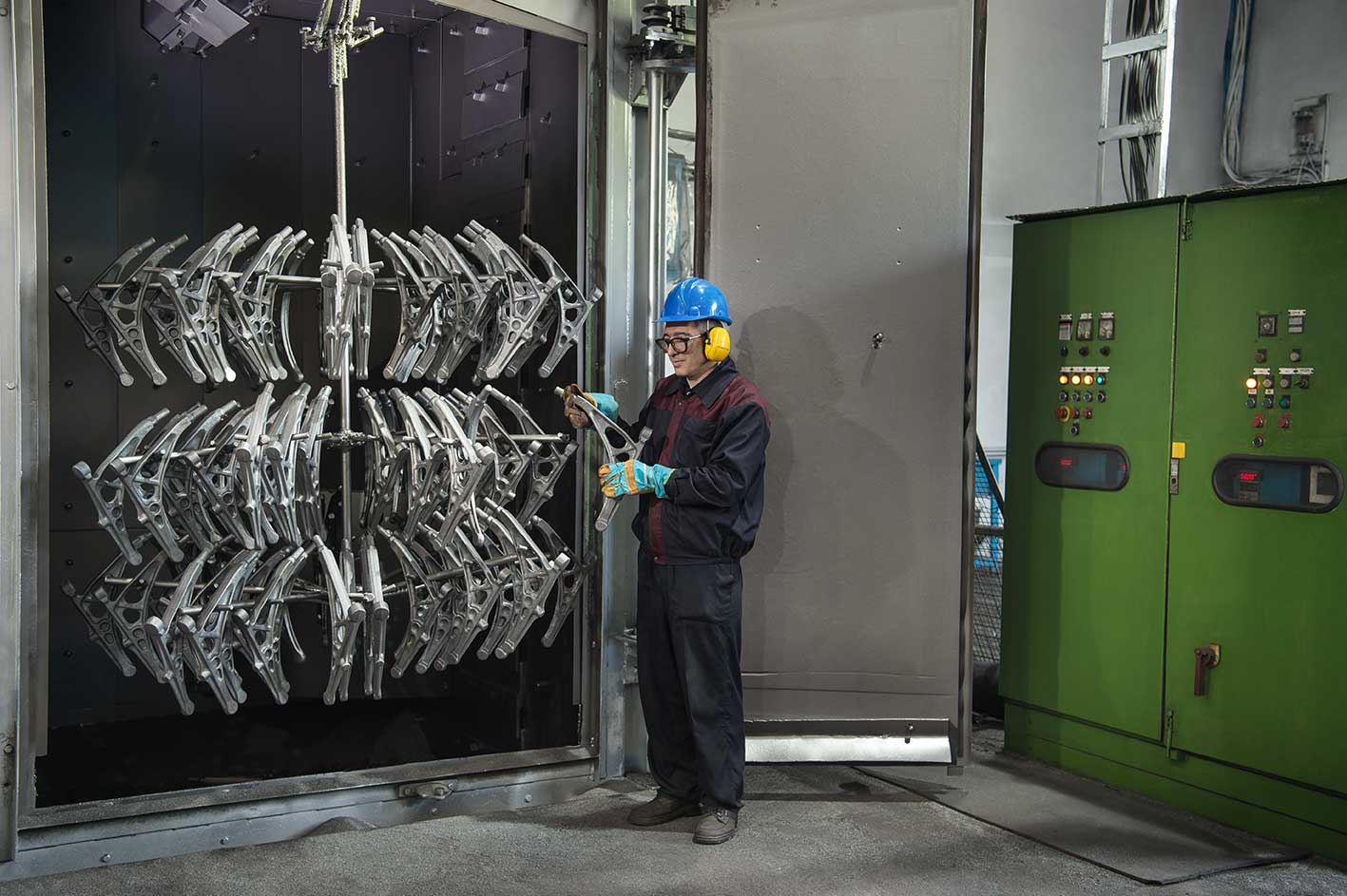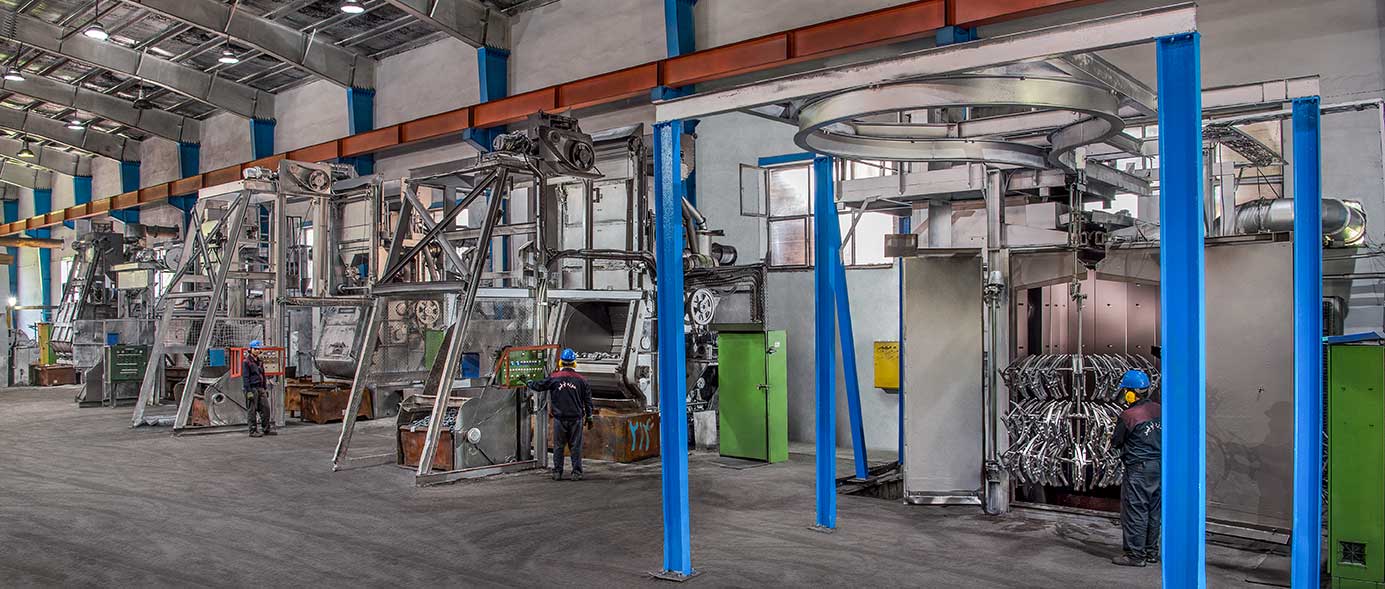Shot blasting refers to a process where a surface of a material is subjected to a bombardment of shot. The shot used for this operation can be of various materials such as steel shot, silicon granules, etc. When this process is carried out, a small amount of the outer surface of the material is removed, which is called shot.
Shot blasting is used to remove rough surfaces of forged parts, rust, and residual paint or to clean and strengthen the piece. After this operation, the parts or wrought iron doors are ready for plating, machining, and painting. In fact, shot blasting eliminates surface defects such as corrosion and microcracks and, by leaving residual stress on the surface of the piece, increases its life. A shot blasting machine typically consists of a turbine, a cleaning cabin or chamber, a recovery system including a collection tank, elevator, separator, and dust collector. Naturally, the naming of these machines varies based on the mechanism of holding the part to be cleaned and how it moves during cleaning.

Barrel-Type Shot Blasting Machines
Machines in this group are categorized into three types: barrel, drum, and continuous barrel. They are an excellent suggestion for batch cleaning of small, lightweight, or medium-sized parts with a relatively similar shape and high production volume. The advantage of these machines over other machines is the polishing capability, which occurs due to the rotation and rolling of the parts over each other.
Barrel Shot Blasting
Barrel shot blasting machines are the oldest type of turbine machines. The operation method is such that the parts are loaded from the top of the barrel; as the barrel rotates, the parts also roll over each other. By spraying shot onto the part while it rotates, all surfaces of the part are cleaned simultaneously. The discharge can also be done from the top or bottom, depending on the customer’s order, the speed of the operation, and the location of the implementation.
Drum-Type Shot Blasting Machines
Drum-type machines represent an evolution of the traditional barrel system. Recognizing the higher wear and tear associated with the loading and unloading of parts in standard barrel machines, innovative systems have been developed to maintain the tumbling action while simplifying the operator’s task. Instead of a barrel, these machines employ a continuously rotating conveyor belt. Parts roll along this belt while being bombarded with shot from above. Once cleaned, the parts are discharged.
The practical application of ideal cleaning principles—involving impact, rotation, vibration, and the tumbling mechanism of parts, coupled with gravity and the shape of the machine’s rollers—not only ensures optimal speed but also enhances efficiency, resulting in a significant economic advantage for these machines and their counterparts. Additionally, this system offers the benefit of polishing the parts and cleaning all their surfaces.
Although these machines are typically classified as batch-type, with certain modifications such as adding more conveyor lines, they can be converted into continuous systems.
Cleaning Objectives and Machine Design
These machines are designed to remove minor flash, clean conical and angled parts, round parts, and holes that must not be damaged during cleaning. They are also capable of removing burrs, deformation, and other surface imperfections. The ability to process high volumes of small parts along with polishing capabilities makes these machines suitable for a wide range of industries, including iron and non-ferrous casting, forging and heat treatment, forging (scale removal), small automotive parts, aluminum die casting, and many others.
These machines are available in various sizes and with different components and accessories according to customer specifications. However, the most common demand is for machines capable of cleaning 150, 250, 300, or 500 kilograms of parts per cycle.
Shot Blasting of Rebars and Wire
Steel rebars and wire are profiles that, according to most construction industry clients, are required to undergo shot blasting. This is not solely for cleaning purposes but often to enhance their quality after the drawing process. Typically, rebars and wire with diameters ranging from 2 to 80 millimeters require cleaning immediately after production, before coating, or sometimes before use. In some cases, they may also be insulated. Therefore, shot blasting machines specifically designed for rebars and wire have been developed. These machines can process the material either longitudinally in single or multiple strands or in coil form. Longitudinal shot blasting of rebars is a continuous process, while shot blasting of coiled wire is typically a batch process.

Table-Type Shot Blasting Machines
Table-type shot blasting machines are highly sought after, especially for cleaning large-sized components where barrel or drum-type machines may cause damage to mechanical properties or dimensions. These machines are user-friendly and offer customizable options, allowing for increased productivity within a closed system.
The tables can be positioned either inside the machine or mounted on the door. Machines with door-mounted tables can be configured with dual systems or multiple tables for enhanced efficiency. All machines designed for this system employ a rotating circular plate on which the workpiece is placed. Shot is then projected from a turbine to cover all angles of the part.
Large-scale industries such as iron and non-ferrous casting, forging, heat treatment, small automotive parts manufacturing, die casting, and machine shops find these machines ideal for batch cleaning processes. In addition to descaling, deburring, oil removal, and sand removal, these machines can also be equipped for shot peening with the installation of specific control equipment. For medium to large machines, the number of turbines can be increased upon customer request. The diameter and quantity of tables determine the machine’s designation, and all options can be customized according to customer specifications.
Monorail Shot Blasting
Given the typically heavy weight, large volume, and high-speed nature of shot blasting, monorail systems are often considered due to their advantages. Both closed-loop (batch) and continuous monorail systems can be employed. While both types function similarly, they feature different equipment, including the configuration of the rails. Modern designs incorporate innovative features that allow even closed-loop systems to accommodate simultaneous loading and unloading, thus reducing speed limitations.
Workpieces, based on their size, weight, and the specific shot blasting requirements, are suspended from overhead cranes or in baskets. As they move along the monorail, they can also rotate around their own axis to ensure complete shot coverage. Turbines are strategically positioned to provide comprehensive shot blasting. The movement of profiles or parts can be customized to suit specific requirements.
Monorail shot blasting systems offer exceptional flexibility and can be adapted to various shot blasting applications. Beyond shot peening and foundry applications, they are widely used in the preparation stages of painting lines in large-scale metal fabrication plants.
Overhead Crane Shot Blasting Systems
The design and construction of these machines take place in large, enclosed spaces. Components are handled using high-capacity monorail crane systems capable of lifting loads of 50,000 kilograms or more. Flexible loading and unloading systems complement these cranes. This method is exceptionally cost-effective and safe for heavy components. By employing turbines and air blast systems, it effectively removes foundry sand and other contaminants. For hard-to-reach areas, a combination of both methods can be used to optimize surface quality.
To maximize flexibility in loading, unloading, and transportation, overhead crane systems can be equipped with one, two, or more supports. Hooks can be single-leg or double-leg, and a variety of grapples can be used. Loading and unloading stations are located outside the machine and operate on separate rails to avoid interference. This design feature provides unparalleled flexibility.
The key advantages of these systems include:
- High capacity: Capable of handling extremely heavy loads.
- Flexibility: Customizable to accommodate various workpiece sizes and shapes.
- Efficiency: Effective removal of contaminants and impurities.
- Safety: Safe operation due to robust design and controlled environment.
- Cost-effective: Economical solution for large-scale cleaning operations.
Wire Mesh Shot Blasting
Wire mesh shot blasting is a specialized type of tunnel-style machine with unique capabilities. These machines are designed for both non-metals, such as stone and ceramics, and metals, particularly thin or soft metals like steel.
Wire mesh shot blasting is the ideal choice for heavy-duty and sensitive casting lines that require cost-effective yet precise operations. Currently, it is widely used for cleaning large die-cast components, as well as wheels, rims, and axles to remove sand and other contaminants from various steel parts. Additionally, these machines are employed in spring shot peening lines.
Dual-Rail Overhead Shot Blasting Systems
Dual-rail overhead shot blasting systems are ideally suited for processing large-scale steel products such as sheets, coils, slabs, billets, welded structures like pipes and gas cylinders, and rods that require etching or surface enhancement. Whether for shot peening or general surface cleaning, these systems can handle heavy, semi-heavy, or even lightweight components while ensuring high-speed processing without damaging the workpiece.
The primary reasons for the popularity of these systems are their high cleaning efficiency, compact design, ease of operation, rapid adaptability to production lines, excellent safety features, effective media separation (by air or magnetic means), simultaneous achievement of cleanliness and improved mechanical properties, and long service life.
A notable characteristic of overhead shot blasting systems is their flexibility in adapting to various workpiece configurations. Components such as hooks and baskets can be easily added or removed, allowing for customization to suit different processing requirements. This adaptability enables the conversion of overhead systems into other configurations, enhancing overall system efficiency. In closed-loop systems, this flexibility is achieved through modifications to the rail system, such as adding a second rail to accommodate heavier loads.
These features have led to widespread adoption of overhead shot blasting systems in large-scale metalworking industries and heavy-duty foundry operations. To ensure optimal performance and longevity, meticulous attention is paid to mechanical and electrical adjustments, and wear-resistant components are used in critical areas such as hooks, clamps, and fasteners. Moreover, machines are delivered with comprehensive documentation and support to facilitate easy setup, operation, and maintenance.
Overhead shot blasting systems are available in a wide range of models and sizes, including:
- Continuous and batch monorail systems
- Spinner systems
- Large overhead chambers
